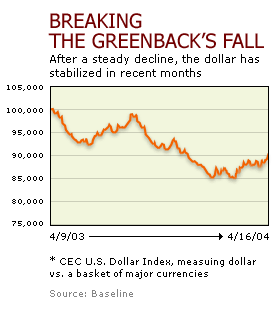NEW YORK (CNN/Money) -
If you're an American planning a trip abroad this spring, have we got good news for you.
The dollar is making a comeback, meaning your vacation will be a bit cheaper than last year, when the greenback was getting hammered.

But if the trend goes too far, U.S. corporate profits, which have gained from the dollar's pain, will have to work harder to keep up the robust growth pace of the first quarter.
Between January 2002 and January 2004, the dollar plunged some 29 percent, compared to a basket of other major currencies, driven by worries about the massive U.S. federal budget and trade deficits with other nations. Treasury Secretary John Snow did little to stop the fall, since the sinking dollar made U.S. exports more competitive overseas, helping to boost U.S. profits and the economy.
But in recent months, the dollar has stabilized. Investors have gotten a whiff of inflation, new jobs and continuing strength in the U.S. economy, while the Euro zone, the United Kingdom and other economies have been less robust.
U.S. bond yields have risen and are expected to go higher, in anticipation of a Fed interest-rate hike some time this year. This, in turn, is making U.S. bonds more attractive than their foreign competitors, giving a further boost to the dollar since overseas investors need dollars to buy Treasury securities.
According to Morgan Stanley, we're at one of the corners of what it calls "the Dollar Smile." When the U.S. and global economies were in recession, the dollar did well because skittish overseas investors sought the safe haven of stable U.S. markets -- that was one corner of the Dollar Smile.
Now that the U.S. economy seems to be running on all cylinders, the dollar should do well, as traders seek to take advantage of rising stock prices and bond yields, the other corner of the Dollar Smile, Morgan Stanley chief currency strategist Stephen Jen wrote in a note to clients on Monday.
"With the strong labor report, strong retail sales, and the strong inflation report, market expectations of a sustainable U.S. recovery have increased," Jen wrote.
| Related stories
|

|
|
|
|
"At the same time, there have been signs that Euroland is losing some momentum. In the Dollar Smile framework, this widening in the growth premium of the U.S. means that we are moving back to [a higher point for the dollar]."
Jen warned, however, that if interest rates were to shoot too high, the resulting damage to the U.S. economy and markets would make the dollar less attractive.
Most currency analysts doubt such a scenario is likely, however. Instead, they see steadier gains in interest rates and the dollar. In fact, if the Fed is less worried about inflation than the markets are, then the upward trajectory for both could be much flatter than expected. Fed chairman Alan Greenspan should offer some clues about that when he speaks to Congress this week.
"The markets have probably been too quick to connect the dots from the current slew of good data straight to a Fed rate hike," said former Fed economist Lara Rhame, now a senior economist and foreign exchange analyst at Brown Brothers Harriman.
"That's one thing Greenspan will clarify on Wednesday, that the concept of patience extends beyond the first rate hike -- they can still move slowly, taking a moderate track.
"That's one of the reasons the dollar came off at the end of last week," Rhame added, "and could come off even more on Wednesday, when Greenspan speaks. He could be setting the foundation for a more range-bound trade for this coming quarter."
A range-bound dollar would be good news for corporate profits. Even though the dollar has stabilized this quarter, it's still weak compared to a year ago, and that's made corporate earnings look healthier than they did a year ago.
Manufacturer 3M (MMM: Research, Estimates), for example, said Monday that a weaker dollar boosted its revenue 6.1 percent, as customers overseas paid in expensive euros, pounds and the like. On Friday,IBM (IBM: Research, Estimates) said a weaker dollar added some 8 percentage points to its quarterly revenue growth.
Not all companies are as exposed to currency fluctuations as 3M, IBM Procter & Gamble (PG: Research, Estimates) and other major multinationals, of course. But the currency boost has been big enough that it's added some 3 percentage points to the S&P's estimated earnings-per-share growth of 20 percent in the first quarter, according to First Call, which tracks corporate earnings.
Still, even if the dollar stays flat, earnings will still get a slight boost through the year, since comparisons to last year would still be favorable, according to First Call research analyst Joe Cooper.
"If the dollar gets above the level we saw in the fourth quarter, then there will start to be a slight detriment to earnings," Cooper said. "The dollar index would have to rise by about 3 percent from where it is now to start even showing up as a slight impact."
In any event, the Dollar Smile is made up of two upward corners and one downward curve. By the second half of the year, when the economy and U.S. stocks are expected to slow down, worries about twin deficits will likely come back to the fore, putting downward pressure on the dollar again, most currency analysts believe.
"After the Fed comes out with its rate hike, and when it communicates to the market that it's satisfied with where rates are for the time being, then we may go back to focusing on the deficits," said Ashraf Laidi, chief currency analyst at MG Financial in New York.

|

